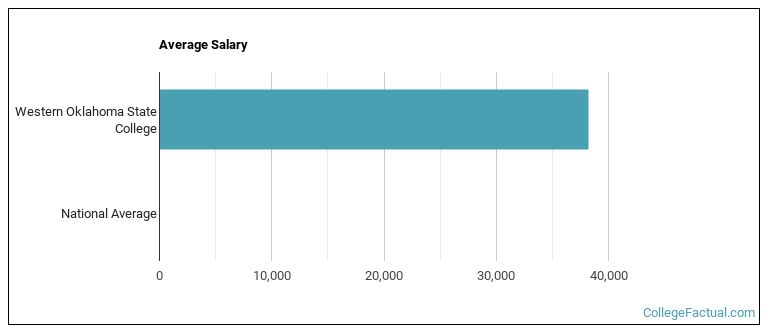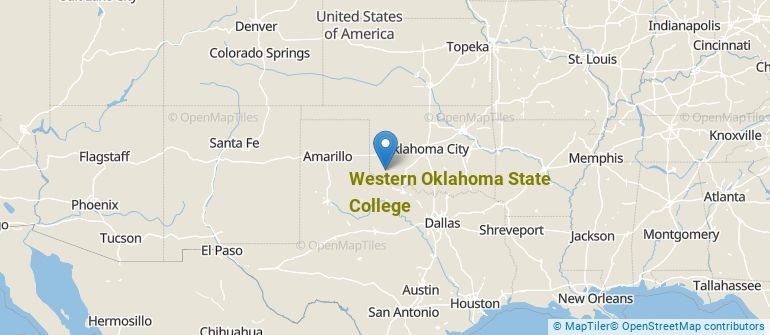 by our College Data Analytics Team
by our College Data Analytics TeamExplore the best ranked schools for the programs you are most interested in.
Western landed the #2,053 spot in College Factual's 2025 ranking of best overall colleges in the United States. The higher ed experts analyzed 2,152 colleges and universities across the nation to determine this ranking. This is an improvement over the previous year, when Western held the #2,083 spot on the Best Overall Colleges list.
Western is also ranked #31 out of 31 schools in Oklahoma.
Western Oklahoma State College has an open admissions policy, so you should not have much trouble being accepted by the school. Still, it is important to fill out the application completely and submit any requested materials, which may include proof that you have a high school diploma or the equivalent.
At Western Oklahoma State College, the student to faculty ratio is 20 to 1. Compared to the national average of 15 to 1, this is somewhat high. This could mean that class sizes may be larger than they are at other colleges or universities or that professors may be required to teach more classes.
When estimating how much access students will have to their teachers, some people like to look at what percentage of faculty members are full time. This is because part-time teachers may not have as much time to spend on campus as their full-time counterparts.
The full-time faculty percentage at Western Oklahoma State College is 43%. This is lower than the national average of 47%.
The freshmen retention rate is a sign of how many full-time students like a college or university well enough to come back for their sophomore year. At Western Oklahoma State College this rate is 62%, which is a bit lower than the national average of 68%.
During the 2017-2018 academic year, there were 1,353 undergraduates at Western with 526 being full-time and 827 being part-time.
The net price is calculated by adding tuition, room, board and other costs and subtracting financial aid.Note that the net price is typically less than the published for a school. For more information on the sticker price of Western, see our tuition and fees and room and board pages.
While almost two-thirds of students nationwide take out loans to pay for college, the percentage may be quite different for the school you plan on attending. At Western, approximately 15% of students took out student loans averaging $4,118 a year. That adds up to $16,472 over four years for those students.
Get more details about paying for Western Oklahoma State College.

See which majors at Western Oklahoma State College make the most money.
Get more details about the location of Western Oklahoma State College.

Contact details for Western are given below.
| Contact Details | |
|---|---|
| Address: | 2801 N Main St, Altus, OK 73521-1397 |
| Phone: | 580-477-2000 |
| Website: | www.wosc.edu/ |
| Most Popular Majors | Bachelor’s Degrees | Average Salary of Graduates |
|---|---|---|
| Nursing | 90 | NA |
| Liberal Arts General Studies | 57 | NA |
| General Agriculture | 27 | NA |
| Business Administration & Management | 25 | NA |
| Human Development & Family Studies | 20 | NA |
| General Psychology | 15 | NA |
| Mathematics | 13 | NA |
| Health & Physical Education | 13 | NA |
| Criminal Justice & Corrections | 5 | NA |
| Air Transportation | 3 | NA |
Online courses area a great option for busy, working students as well as for those who have scheduling conflicts and want to study on their own time. As time goes by, expect to see more and more online learning options become available.
In 2022-2023, 1,100 students took at least one online class at Western Oklahoma State College. This is an increase from the 949 students who took online classes the previous year.
| Year | Took at Least One Online Class | Took All Classes Online |
|---|---|---|
| 2022-2023 | 1,100 | 660 |
| 2021-2022 | 949 | 597 |
| 2020-2021 | 1,084 | 645 |
| 2018-2019 | 795 | 405 |
Learn more about online learning at Western Oklahoma State College.
Footnotes
*The racial-ethnic minorities count is calculated by taking the total number of students and subtracting white students, international students, and students whose race/ethnicity was unknown. This number is then divided by the total number of students at the school to obtain the racial-ethnic minorities percentage.
References
More about our data sources and methodologies.